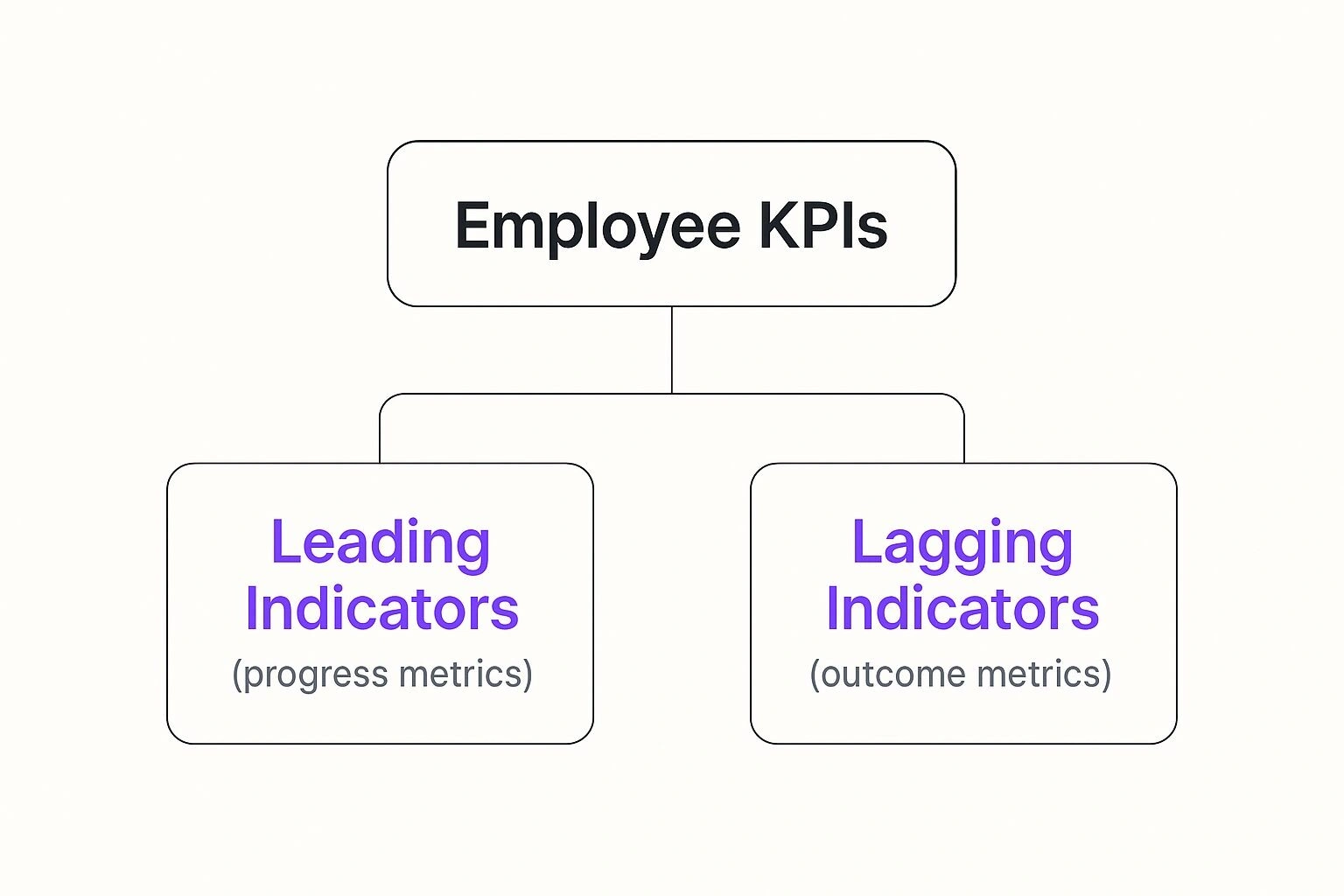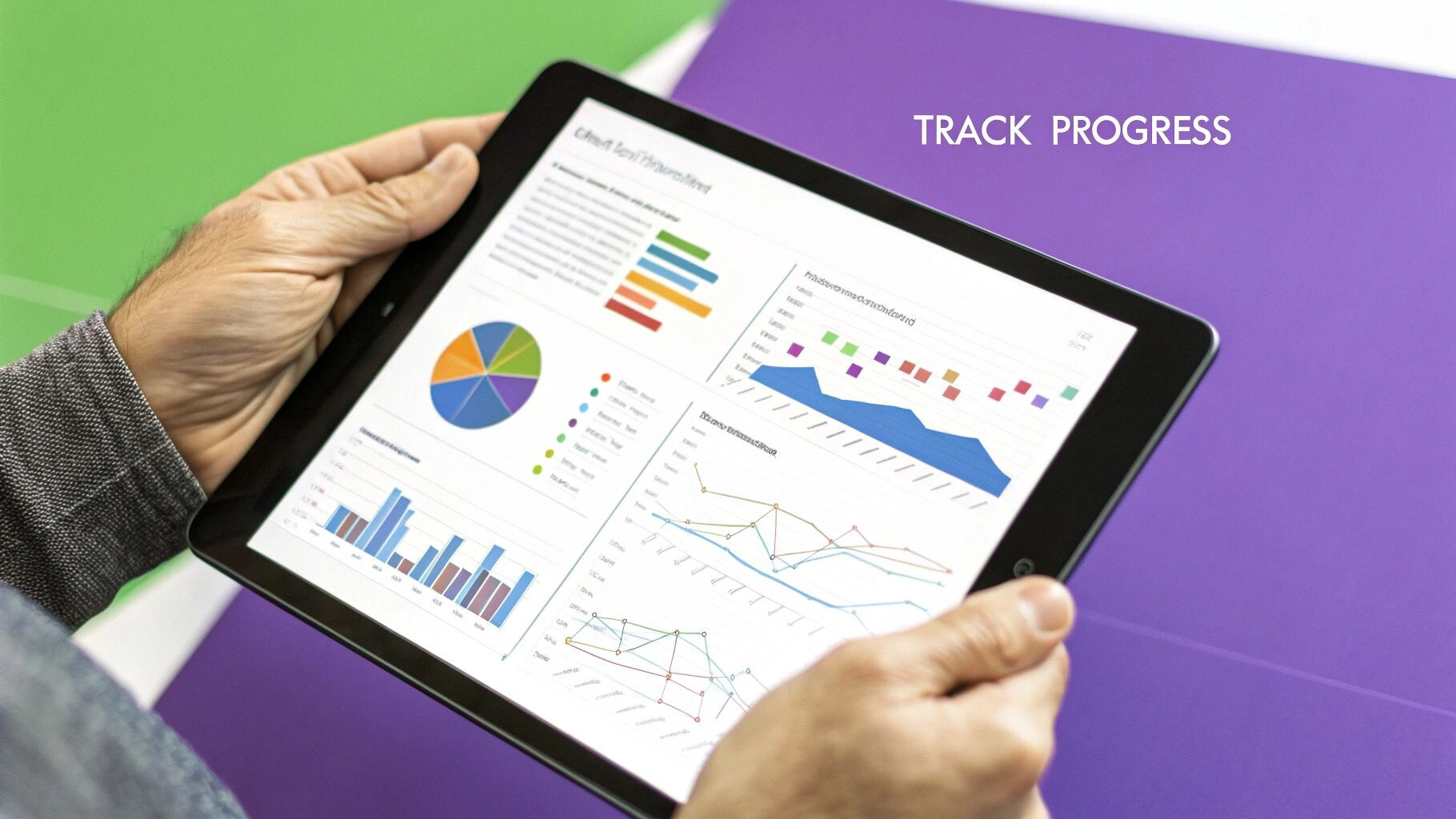Key Performance Indicators for Employees: Boost Team Success
Learn how to set effective key performance indicators for employees that motivate your team and drive real results. Discover tips to make KPIs meaningful.

Key Performance Indicators (KPIs) for employees are the specific, measurable signposts that track how an individual’s work contributes to the bigger picture. Think of them less as a report card and more as a roadmap, showing exactly how daily efforts connect to the company’s most important goals. They provide both purpose and direction.
So, What Exactly Are Employee KPIs?
Employee Key Performance Indicators (KPIs) aren’t about micromanagement; they’re about creating a shared language for what success looks like. They build a clear, measurable bridge between a person’s day-to-day tasks and the organisation’s loftiest ambitions.
A well-crafted KPI gives a team member a data-backed answer to the vital question: “Is my work actually making a difference?” This clarity is everything. When people know precisely what’s expected of them and see how their contributions are measured, it replaces vague notions of ‘doing a good job’ with a tangible sense of purpose.
Getting to the Core of KPIs
At their heart, employee KPIs are about focusing on what truly matters. It’s easy to get bogged down tracking activity—the number of emails sent, hours logged, or meetings attended. But these “vanity metrics” rarely tell the full story about impact. Effective KPIs force a shift from simply being busy to genuinely being productive.
Take a customer service representative, for instance. Judging their performance solely on the number of calls they handle per day is a classic mistake. A much more insightful set of KPIs would look at the quality and efficiency of their work, such as:
- First Contact Resolution (FCR) Rate: What percentage of customer issues are solved on the very first try?
- Customer Satisfaction Score (CSAT): How happy are customers with the service they received, based on direct feedback?
- Average Resolution Time: How quickly are issues being resolved from start to finish?
These metrics paint a far richer, more accurate picture of performance and its direct effect on customer loyalty and business health.
The Four Core Types of Employee KPIs
To really understand KPIs, it helps to break them down into fundamental categories. Each type measures performance from a different angle, giving you a holistic view.
Here’s a quick breakdown of the four core types:
| KPI Category | What It Measures | Typical Example |
|---|---|---|
| Quantitative KPIs | The “how much” or “how many.” Purely numerical and objective. | Monthly Sales Revenue, Number of Units Produced |
| Qualitative KPIs | The “how well.” Subjective and measures quality, often based on opinion. | Customer Satisfaction Score, 360-Degree Feedback Rating |
| Leading Indicators | The “inputs.” Predicts future outcomes and measures progress. | Number of Sales Demos Scheduled, Hours Spent on Training |
| Lagging Indicators | The “outputs.” Measures past results and confirms long-term trends. | Quarterly Profit, Annual Employee Turnover Rate |
By using a mix of these KPI types, you can track not just where you’ve been, but also where you’re headed.
Leading vs. Lagging Indicators: Looking Forward and Looking Back
Digging a bit deeper, the distinction between leading and lagging indicators is particularly important. These two types work in tandem to give you a complete performance picture. Leading indicators are your headlights, illuminating the road ahead, while lagging indicators are your rearview mirror, showing you the ground you’ve already covered.
You need both to navigate effectively.

As the diagram shows, leading indicators are progress-focused metrics that can influence future success. Lagging indicators, on the other hand, measure the results you’ve already achieved. A balanced approach is crucial for any robust performance strategy.
Key Takeaway: Leading indicators are proactive and let you influence future results (like weekly sales demos), while lagging indicators are reactive and measure past success (like quarterly revenue). You need both to steer the ship and check the map.
Frameworks like Objectives and Key Results (OKRs) are also incredibly useful for setting these performance targets with clarity. Ultimately, the goal of any performance measurement system is to create alignment, build motivation, and drive results that genuinely matter across the entire organisation.
Why Clear KPIs Are Your Secret Weapon
Setting Key Performance Indicators for your employees is so much more than a box-ticking exercise for managers. When you get it right, it becomes a genuine strategic advantage. Well-crafted KPIs act as a bridge, translating lofty company goals into concrete, daily actions for every single person on your team. They cut through the noise and ambiguity, creating a shared language for what success actually looks like in each role.
This clarity is incredibly empowering. Instead of trying to read the minds of leadership, your people get a transparent roadmap. They can connect the dots between their work and the company’s progress, which fosters a powerful sense of ownership. This isn’t just about warm feelings; it’s about focusing effort where it counts, which directly strengthens your bottom line.
Boosting Engagement and Reducing Turnover
Nothing disengages an employee faster than a lack of direction. When people don’t know what they’re aiming for, frustration builds, and you start to see your best talent heading for the door. Clear KPIs are the antidote, providing the structure and focus that high-achievers thrive on.
Time and time again, we see a direct link between an employee understanding their role and their overall job satisfaction. Knowing you’re accountable for a customer retention rate of 95% or responsible for reducing project cycle time by 10% gives your work immediate meaning. It has a real, tangible effect on retention.
When a company uses performance data to guide how they develop and recognise their people, turnover drops. It sends a powerful message: we see your contribution, we value it, and there’s a fair and clear path for you to grow here.
This transforms performance reviews from awkward, subjective chats into objective, data-led coaching sessions that are genuinely focused on improvement.
Aligning Departments for Peak Performance
In too many businesses, departments work in silos. Each team chases its own goals, often without seeing how their work impacts anyone else. This creates friction, wastes resources, and grinds progress to a halt. Properly defined Key Performance Indicators for employees act as the connective tissue, pulling every team towards the same mission.
Think about this common setup:
- The Sales Team’s KPI: Increase new customer acquisition by 15% this quarter.
- The Marketing Team’s KPI: Generate 500 marketing-qualified leads (MQLs) per month.
- The Customer Success Team’s KPI: Achieve a 90% onboarding satisfaction score.
When these KPIs are visible to everyone, collaboration naturally follows. Sales understands its reliance on marketing’s leads. Customer Success knows that the quality of the initial sale directly affects their ability to keep clients happy. It creates a domino effect where teams aren’t just working alongside each other; they’re actively invested in each other’s success because their metrics are intertwined.
Driving Data-Backed Strategic Decisions
Ultimately, the real power of employee KPIs is the data they produce. This stream of information gives leadership a clear, objective lens to look through when assessing performance. It pulls critical decisions out of the realm of “gut feelings” and anchors them in solid evidence.
This kind of objective insight is gold for making smarter strategic moves:
- Identifying Top Performers: Look beyond just revenue to see who truly excels in efficiency, quality, or customer satisfaction. This allows for promotions that are both fair and impactful.
- Pinpointing Training Needs: If an entire team is missing the mark on a specific KPI, like “First Contact Resolution,” it’s a clear signal you need targeted training, not another generic workshop.
- Optimising Resource Allocation: When you know which teams and activities are driving the most critical outcomes, you can allocate your budget and people with far more confidence and precision.
By turning “performance” from a vague idea into a set of measurable results, you give your entire organisation the tools it needs to constantly improve. KPIs stop being a chore and become your most effective weapon for executing your strategy.
Finding the Right Mix of Performance Metrics

Relying on just one type of performance metric is a bit like trying to judge a five-star meal by only looking at a photo of it. You see one part of the picture, but you miss the aroma, the flavour, and the texture. To get a full, meaningful understanding of an employee’s contribution, you need to blend different kinds of Key Performance Indicators (KPIs).
A lopsided approach will always create blind spots. If you only chase output, quality will almost certainly suffer. And if you only look at what’s already happened, you’ll be completely unprepared for what’s coming next. The real art is in creating a multi-dimensional view that captures both the ‘what’ and the ‘how’ of performance.
The Numbers Game: Quantitative KPIs
Quantitative KPIs are your nuts-and-bolts metrics. They are objective, numerical, and answer the simple questions: “how much?” or “how many?”. These indicators form the foundation of performance measurement because they give you hard, indisputable data that’s easy to track over time.
Think of them as the scoreboard in a footy match. They tell you the final score—a clear, objective measure of the outcome.
For instance, a sales executive might have a quantitative KPI like $50,000 in new monthly recurring revenue. A factory worker could be measured on producing 200 units per shift. These are direct, black-and-white numbers with very little room for debate.
Measuring the Intangibles: Qualitative KPIs
But as we all know, numbers don’t tell the full story. This is where qualitative KPIs come in, measuring the “how well” aspects of someone’s work. While they can be more subjective—often based on observation, feedback, or professional judgement—they are absolutely critical for understanding the context behind the raw data.
High output is fantastic, but not if it’s achieved by cutting corners or alienating the rest of the team. A software developer might have a KPI for code quality, which is assessed through peer reviews. A manager’s performance could be measured by their team’s employee satisfaction scores from the latest survey.
A purely quantitative approach can incentivise the wrong behaviours. For instance, a support agent focused solely on closing as many tickets as possible might rush through calls, leading to poor customer experiences and unresolved issues that resurface later.
By blending both quantitative and qualitative metrics, you get a much more holistic and fair assessment of an employee’s total contribution.
Predicting Success with Leading Indicators
Leading indicators are your crystal ball. These are forward-looking metrics that help predict future outcomes by measuring the activities and behaviours that drive success. Think of them as the early warning signs of an engine problem; they’re proactive and give you a chance to make adjustments before it’s too late.
These metrics are incredibly powerful because they give you influence over what’s to come. By keeping an eye on leading indicators, you can spot potential roadblocks early and steer things back on track.
- For a Sales Team: Instead of only looking at closed deals (a lagging indicator), you would track the number of qualified demos scheduled per week. This leading indicator predicts future sales.
- For a Marketing Team: The number of new email subscribers is a leading indicator for future engagement and potential sales conversions.
- For Employee Development: Tracking the percentage of employees completing a new training program is a leading indicator of future skill improvement and productivity.
Confirming Results with Lagging Indicators
On the other side of the coin, lagging indicators measure past performance. They are the ‘output’ metrics that confirm the final result of your efforts and show long-term trends. While they can’t predict what’s next, they are essential for validating whether your strategies actually worked.
Common examples include quarterly profit, the annual employee turnover rate, and total revenue. These are historical data points that offer definitive proof of performance. The catch, of course, is that by the time you measure them, the performance period is over, leaving you no opportunity to change the outcome.
A truly effective system uses a combination of all four types, creating a balanced and insightful performance picture. To streamline the process, you might also want to explore common features of employee performance tools designed to track this kind of data. This balanced approach ensures you are not just measuring past achievements but are also actively shaping future success.
How to Choose KPIs That Actually Motivate

Choosing the right Key Performance Indicators isn’t really about measurement; it’s about motivation. If you get it wrong, you can inadvertently create anxiety, push people to chase the wrong tasks, and pave a fast track to burnout. The real aim is to build a framework that gives people a clear, achievable target that genuinely reflects their contribution to the business.
This means moving beyond simply tracking activity. It’s about sparking the right behaviours that deliver tangible results. Think of it as the difference between telling someone to “make more calls” versus empowering them to “increase customer retention by 5%.” One is a chore; the other is a goal with real impact.
Start with the SMART Framework
The SMART framework has stood the test of time for a reason. It’s a brilliant starting point for crafting KPIs that have teeth, acting as a simple checklist to ensure your metrics are well-defined and serve a real purpose. A solid KPI needs to be:
- Specific: It has to target a precise area for improvement. “Improve customer service” is far too vague. “Reduce average ticket response time to under 2 hours” is specific.
- Measurable: You have to be able to track progress with hard data. If you can’t measure it, you simply can’t manage it.
- Achievable: The goal must be challenging yet realistic. Setting an impossible target is one of the quickest ways to demoralise your team.
- Relevant: The KPI must directly connect to broader team and company goals. It has to answer the crucial question: “Why does this matter?”
- Time-bound: There must be a clear deadline, like “by the end of Q3.” This creates a natural sense of urgency and a finish line to work towards.
Using this structure helps you sidestep those fuzzy, feel-good ‘vanity metrics’ and forces you to focus on what is truly important and actionable.
Align KPIs from the Top Down
For KPIs to truly motivate, your team needs to see a clear line of sight from their individual goals all the way up to the company’s grand strategy. When metrics feel disconnected, they just seem like busywork. But when they’re aligned, they provide a powerful sense of purpose.
It’s about creating a cascade of clarity. Imagine your company’s top-level goal is to increase market share by 10%. That single objective should flow down through every department:
- Company Goal: Increase market share by 10%.
- Marketing Team Goal: This translates into a team KPI of generating 2,000 new Marketing Qualified Leads (MQLs) per quarter.
- Individual Content Marketer’s KPI: To do their part, their personal KPI might be to increase organic blog traffic by 15% each month, as this is a direct lever for lead generation.
When that content marketer sees exactly how their daily work feeds into the team’s goal, which in turn drives the company’s success, their work suddenly has context and importance. Tracking this connection is easier than ever with various marketing automation tools that can show how specific content efforts contribute to lead generation.
Involve Employees in the Process
One of the most common mistakes leaders make is creating KPIs in a vacuum and handing them down from on high. This top-down mandate rarely secures buy-in and often results in metrics that are completely out of touch with the realities of the role.
Involving employees in the KPI selection process is not about letting them choose their own targets. It’s about a collaborative dialogue to ensure the metrics are relevant, fair, and achievable.
This simple act of collaboration builds a sense of ownership. When someone helps define their own measures of success, they are naturally more invested in the outcome. It also gives managers crucial on-the-ground insights, helping to avoid setting KPIs that are impractical or fail to capture the full scope of a person’s responsibilities.
Avoid Common KPI Traps
Even with the best of intentions, it’s surprisingly easy to fall into a few common traps that can derail your entire performance management system.
- KPI Overload: The ‘less is more’ principle is your best friend here. Assigning an employee 3-5 core KPIs is the sweet spot. Any more, and you risk diluting their focus, leading to confusion as they try to juggle too many competing priorities.
- The Vanity Metric Fascination: Be ruthless about cutting metrics that look impressive on a slide but don’t actually move the needle. A huge number of social media followers is a classic vanity metric; the number of leads generated from social media is a meaningful KPI.
- Ignoring the “How”: Focusing only on the final numbers can encourage people to hit their targets at any cost—sometimes sacrificing quality or ethics along the way. It’s vital to balance what was achieved with how it was achieved by including qualitative measures in your reviews.
By carefully selecting, aligning, and co-creating your key performance indicators for employees, you can turn them from a rigid scorecard into a dynamic tool that inspires growth, fosters engagement, and drives the entire organisation forward.
Building a Culture of Performance and Trust

You can pick the most brilliant, data-backed employee KPIs in the world, but they will absolutely fall flat if you drop them into a culture of mistrust or poor communication. The metrics themselves are just numbers on a screen; their real power is only unleashed when they’re woven into the very fabric of your company culture as tools for growth, not as instruments of judgment. This takes a deliberate, conscious effort to build an environment where performance management is seen as a supportive, collaborative process.
The cornerstone of this culture is transparent and consistent communication. From the get-go, leaders need to clearly articulate the why behind the KPIs. It’s not enough to just roll them out. Employees need to understand how these metrics connect to the company’s bigger mission and, just as importantly, to their own career development. This isn’t a one-and-done announcement but an ongoing conversation.
Shifting from Annual Reviews to Continuous Feedback
Let’s be honest: the traditional annual performance review is an outdated, often ineffective, model. Hoarding a year’s worth of feedback and data for one high-stakes meeting creates anxiety for everyone involved and rarely leads to any meaningful improvement. The most effective performance cultures today are built on a foundation of continuous feedback.
Instead of that single yearly event, managers should be having regular, informal check-ins. These sessions—whether weekly or monthly—transform the manager’s role from a distant judge into an active coach. The whole conversation shifts from, “Here’s what you did wrong last quarter,” to, “How can I support you in hitting your targets this month?”
This continuous loop of communication delivers some serious benefits:
- Timely Adjustments: It allows for real-time course corrections, so small issues can be addressed before they snowball into major problems.
- Reduced Anxiety: Frequent, low-stakes conversations make performance discussions a normal part of the work week, not a dreaded annual event.
- Stronger Relationships: It naturally builds a more trusting and supportive relationship between managers and their team members.
Cultivating an Atmosphere of Trust
For KPIs to truly work, employees must trust that the data will be used to help them, not to punish them. Creating this psychological safety is non-negotiable. Leaders have to demonstrate, through their actions, that missing a KPI isn’t a failure—it’s an opportunity to learn, analyse the situation, and adjust the strategy.
When a team member falls short of a KPI, the first question should never be, “Why did you fail?” It should be, “What obstacles are in your way, and how can we remove them?” This simple reframe is critical for building a culture where people feel safe enough to take calculated risks and innovate without fear of reprisal.
This supportive approach is especially vital in the current Australian market. Creating a positive culture directly impacts retention, which is a critical KPI for any business. With only 52% of Australian workers intending to stay with their current employer for more than three years—well below the global average of 64%—organisations are facing significant turnover risks. A culture of trust and support, measured through KPIs like inclusion scores and engagement levels, is essential for stability and growth.
Overcoming Resistance and Ensuring Buy-In
It’s natural for people to resist new performance metrics. Employees might worry about being micromanaged or judged unfairly. The key to moving past this resistance is a three-pronged attack: clear communication, comprehensive training, and using technology to make the whole process simple and transparent.
Managers need training not just on the KPIs themselves, but on how to have effective coaching conversations around them. Giving everyone simple, accessible tracking systems is also a game-changer. When team members can easily see their own progress in real-time, it demystifies the process and puts them back in control of their performance story. Automating parts of this can also make a huge difference; understanding the basics of business process automation can show you how to streamline data collection and reporting, freeing up managers to focus on coaching, not administration.
Ultimately, building this culture comes down to consistency. When your team sees that KPIs are used fairly, that feedback is always constructive, and that the system is genuinely designed to support their success, trust will follow. That’s how performance management transforms from a top-down mandate into a shared commitment to excellence.
Using KPIs to Tackle Employee Burnout
While well-designed key performance indicators for employees are fantastic for motivation, they can become a direct pipeline to burnout when managed poorly. If your metrics only hammer home the need for output without any regard for human capacity, you’re unintentionally fuelling stress and disengagement across the entire team.
This creates a massive blind spot for many organisations. The good news is that the same data-driven thinking you apply to performance can be flipped on its head to proactively protect your team’s wellbeing. Instead of waiting for burnout to decimate morale and productivity, you can use KPIs to spot the early warning signs.
It’s all about introducing indicators that measure the pressure building up within the system, not just what’s coming out the other end. You’re essentially using your data to ask a completely different, and arguably more important, set of questions.
Shifting Focus to Wellbeing Metrics
By tracking specific wellbeing metrics, you can transform KPIs from a source of stress into a powerful tool for support. These indicators give you objective, real-time data on employee strain and workloads, allowing you to step in long before a small problem becomes a crisis.
Think about adding these leading indicators of burnout to your management dashboards:
- Workload Balance: Keep an eye on metrics like the average number of tasks per employee or the ratio of projects to people. This quickly highlights who is consistently taking on too much.
- Overtime Trends: A sustained increase in after-hours work for an individual or a team is a classic red flag. It’s a sure sign of an unsustainable pace and mounting pressure.
- Paid Time Off (PTO) Utilisation: It might sound counterintuitive, but low PTO usage is a problem. It often means people feel they simply can’t take a break, which is a fast track to exhaustion.
- Communication Patterns: Even simple things like the timing and volume of emails can tell a story about work-life boundaries. To get a better handle on this, you can explore various tools for managing workplace communication, like our overview of Gmail productivity add-ons.
Proactively monitoring wellbeing KPIs isn’t just a ‘nice to have’—it’s a core business strategy to protect your most valuable asset, reduce turnover, and sustain long-term productivity.
This isn’t a minor issue; it’s a growing challenge for Australian businesses. Research from 2025 revealed that 40% of workers were already feeling burnt out, with many expecting their stress levels to keep rising. When you consider the astronomical cost of employee turnover, using smart KPIs to get ahead of burnout becomes an essential business function. You can read the full research about Australian worker burnout to grasp the true scale of the problem.
Frequently Asked Questions About Employee KPIs
When you start digging into key performance indicators for employees, a lot of practical questions naturally pop up. Getting straight answers is the key to building a performance framework that actually works, rather than just becoming another box-ticking exercise. Let’s tackle some of the most common queries I hear from managers.
These questions usually start broad, at the strategy level, then drill down into the nitty-gritty of day-to-day management. Getting your head around these details is what makes your KPIs powerful tools for growth, not just another report to fill out.
How Many KPIs Should an Employee Have?
When it comes to KPIs, less is almost always more. You should be aiming for 3-5 core KPIs for any single role. Any more than that, and you risk diluting focus. A tight set of metrics keeps your team locked on what genuinely moves the needle, preventing that feeling of being pulled in a dozen different directions at once.
The whole point of setting key performance indicators for employees is to measure impact, not to catalogue every single task someone does. Go beyond five, and you’ll find the truly critical objectives get lost in the noise of less important metrics.
A crowded dashboard is a useless dashboard. By limiting KPIs, you force clarity and ensure that both the employee and the manager are aligned on the most vital contributions for that role. This focus is what turns measurement into genuine performance improvement.
How Often Should We Review Employee KPIs?
KPIs aren’t something you can just ‘set and forget’ until the annual performance review rolls around. That’s a recipe for disaster. For these metrics to be effective, they need to be part of a regular, ongoing conversation. Best practice is to have consistent check-ins, usually on a monthly or quarterly basis.
This regular catch-up turns KPIs from a static report card into a living, breathing tool for continuous development. It creates space for timely feedback, allows you to make course corrections, and provides the flexibility to adjust as business priorities inevitably shift. It transforms the review from a single, high-stakes judgement day into a collaborative coaching dialogue.
Can We Use KPIs for Overall Team Performance?
Absolutely. While this guide has focused mainly on individual metrics, team-based KPIs are incredibly powerful. They’re fantastic for building a sense of shared ownership and encouraging collaboration. In fact, the most effective performance systems I’ve seen almost always blend both.
For instance, you might pair individual sales targets with an overarching team KPI for customer satisfaction or project completion rates. This approach encourages everyone to pull in the same direction, creating a balanced system that rewards both personal accountability and collective success.
Ready to unlock hidden efficiencies and build a data-driven culture? Osher Digital empowers your organisation with custom automation and AI agent development to connect your systems and streamline your business. Stop letting manual processes hold you back and discover how we can help you scale. Visit us at https://osher.com.au to learn more.
Jump to a section
Ready to streamline your operations?
Get in touch for a free consultation to see how we can streamline your operations and increase your productivity.